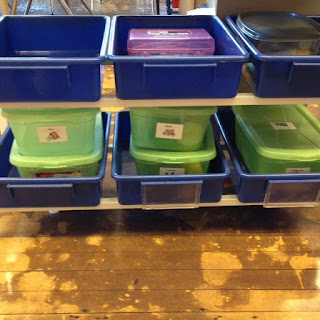Here are just some examples of sensory strategies you can try with your students...please leave me comments with any other ideas you have found to be successful...I love to hear things that are working for your students!
1. Sensory Bins:
Fill a tub with moon sand, rice, sand, beans, feathers, table scatter, play dough, etc. You can put toys inside for students to search for, or things like funnels and scoops for them to use to dump/pour the items.
2. Break Times:
Depending on your students' needs, you can schedule breaks for your students or teach them to request a break. Even for my students who needed regularly scheduled break times, this looked very different based on individual needs. Some of my students only needed 1 break in the morning and 1 in the afternoon. Other students had breaks scheduled after three activities (about 1 time per hour), and for others, breaks were needed after EVERY work task (i.e. work for 15 minutes, then break for 15 minutes).
3. Have a specific break area in your room:
Set it up with calming activities (bean bag, big yoga bouncing ball or trampoline, weighted blankets, etc.).
In one classroom I supported, students had to self assess where they were at (on the 5 Point Scale) before taking a break, then choose a calming activity to engage in (each student had different choices that had been pre-taught), set a timer for a given amount of time, then self assess where they were at (on the 5 Point Scale) after taking their break.
Another teacher I worked with had a calming corner in her gen ed classroom with a sand timer. ALL students could go over whenever they wanted and set the timer, take their break, and then return to the group.
Recess is SO NECESSARY for all kids. They need time to get up and move during their day and get out their wiggles. If your school doesn't have recess, advocate for your students. If you do have recess, try not to take it away from students as a punishment...they need this time to help them be ready to focus and learn in the classroom.
5. Movement Breaks:
Regardless of if you have recess or not, have you tried GoNoodle in your classroom? This is an awesome website with songs/movements/activities to get kids up and moving for short brain breaks during the day. These are great to use during transition times as well!
When creating my students' schedule, I had them changing activities every 15 minutes. I know, it adds up to a lot of activities during the day, but it HELPED! It got my students up and moving and it allowed them to move quickly from activity to activity so they didn't get as bored or overwhelmed with difficult work.
7. Variety of hands-on activities:
Nobody wants to sit and read out of a text book or do worksheets all day. Include activities in your schedule that involve different senses and movement while also targeting students areas of need. Use cooking to teach reading/following directions, finger painting to teach patterns, gel bags to work on letters, etc.
There are a ton of different seating options out there. Let students sit, stand, use special cushions, or even ball chairs. Give students choices, but also teach them how to use the materials correctly and appropriately.
Which brings me to...
9. Fidgets:
Ok, fidget spinners, fidget cubes, special putty that changes color...these are all super hip and "in" right now. There is definitely a time and place for them (I admit I have some at my desk that I often use while in meetings or when I am feeling stressed out)...they work, but they can also be distracting. So instead of just seeing a squirrely kid and saying, "I know, give him a fidget, that will fix everything," we need to
a) teach the kid how to use a fidget appropriately,
b) figure out if a fidget will even help this student (you may need to try a couple...and definitely consult with your OT on this one) and
c) maybe try some of the other strategies listed above in addition to your fidgets
Try using visual rules and posting them someplace all your students can see so you don't have to verbally remind them all day long.
10. Data
Use data to determine whether or not these strategies are effective...Pick a specific behavior (i.e. staying seated or staying in an assigned desk area) and take data for at least 1 day to see how many times they stand up or how many minutes they can stay seated. Then, implement your strategy and take data again for a few days. Did it get better? If not, do you need to teach the student some skills about how to use the new strategy? Can you add a visual to help the student use the strategy independently? Can you have the student take data on themselves (self management/monitoring)?
What works in your classroom? How do you determine whether or not sensory strategies are effective? Any OTs out there who have some expert advice for us?!













No comments:
Post a Comment